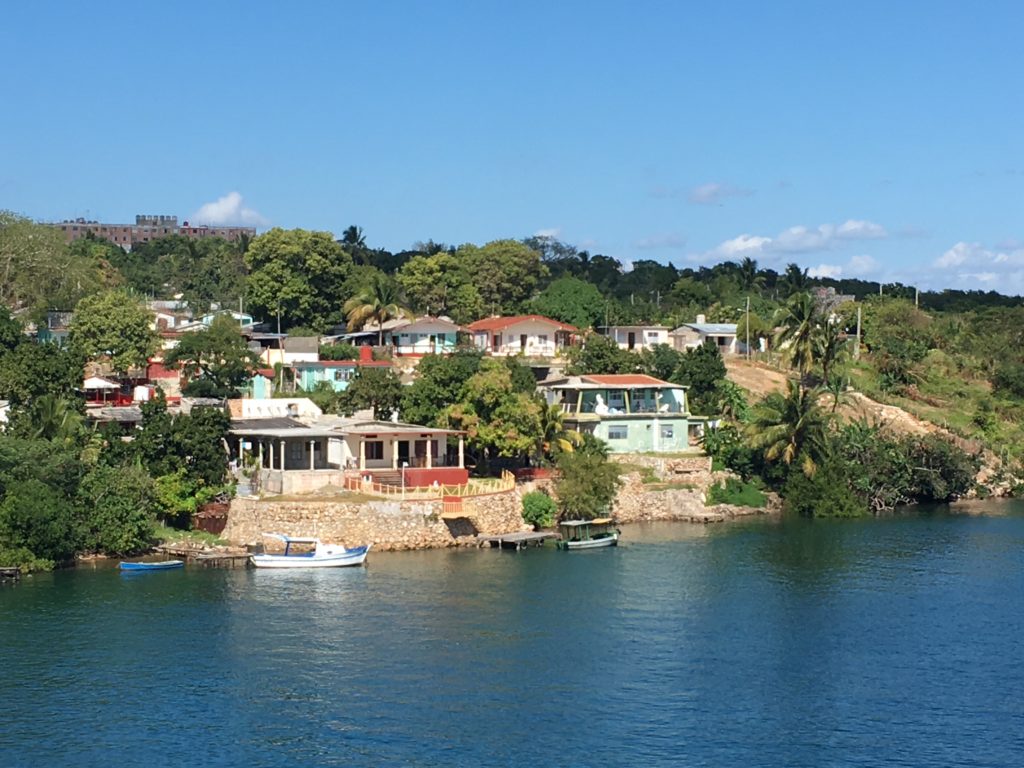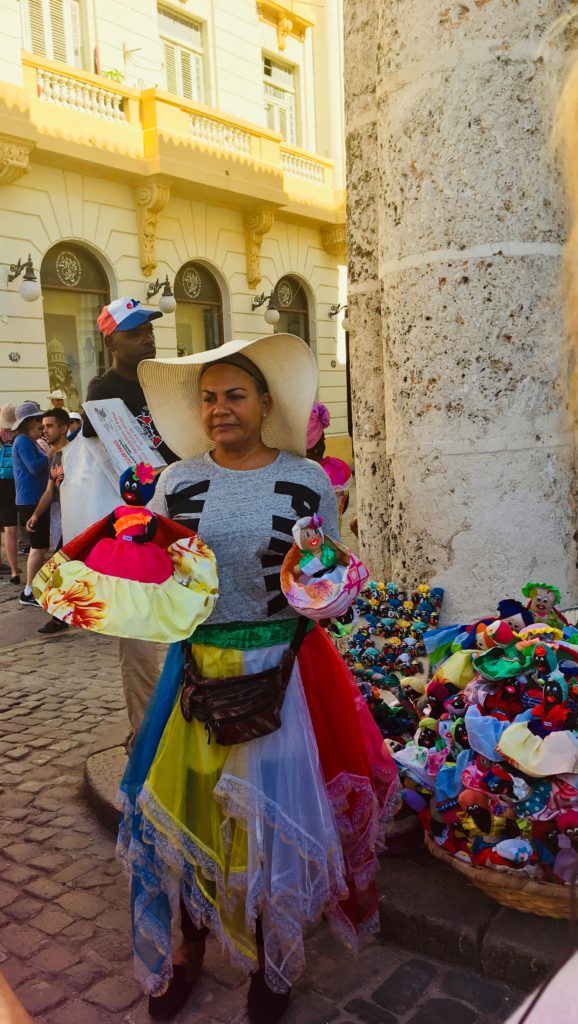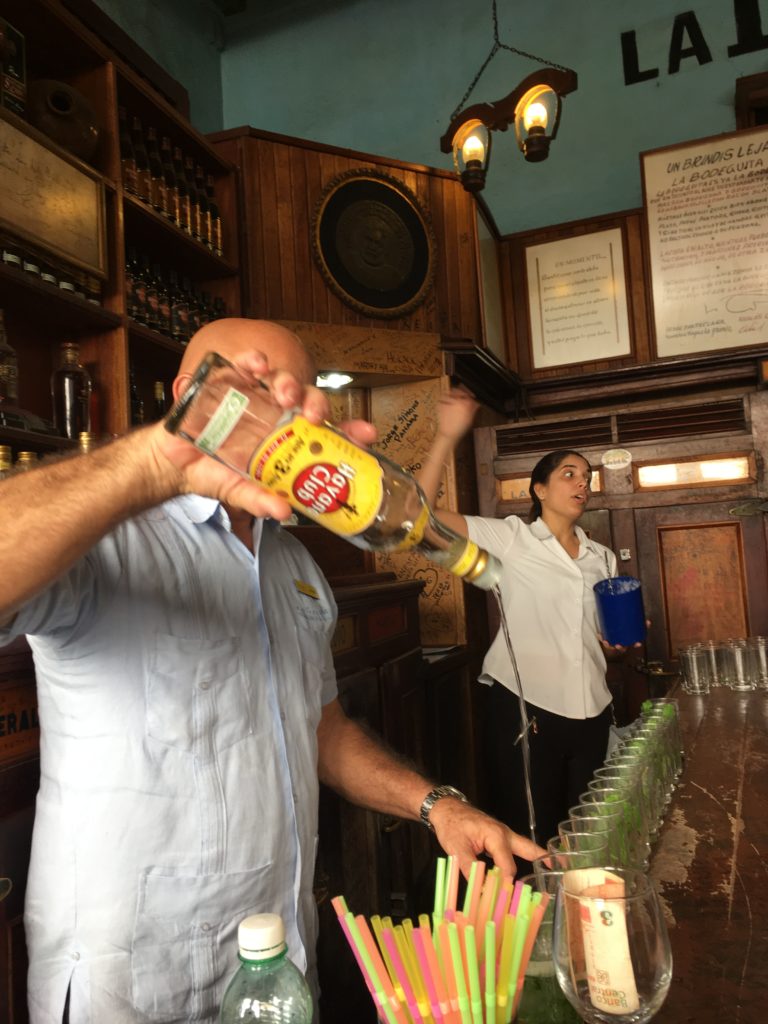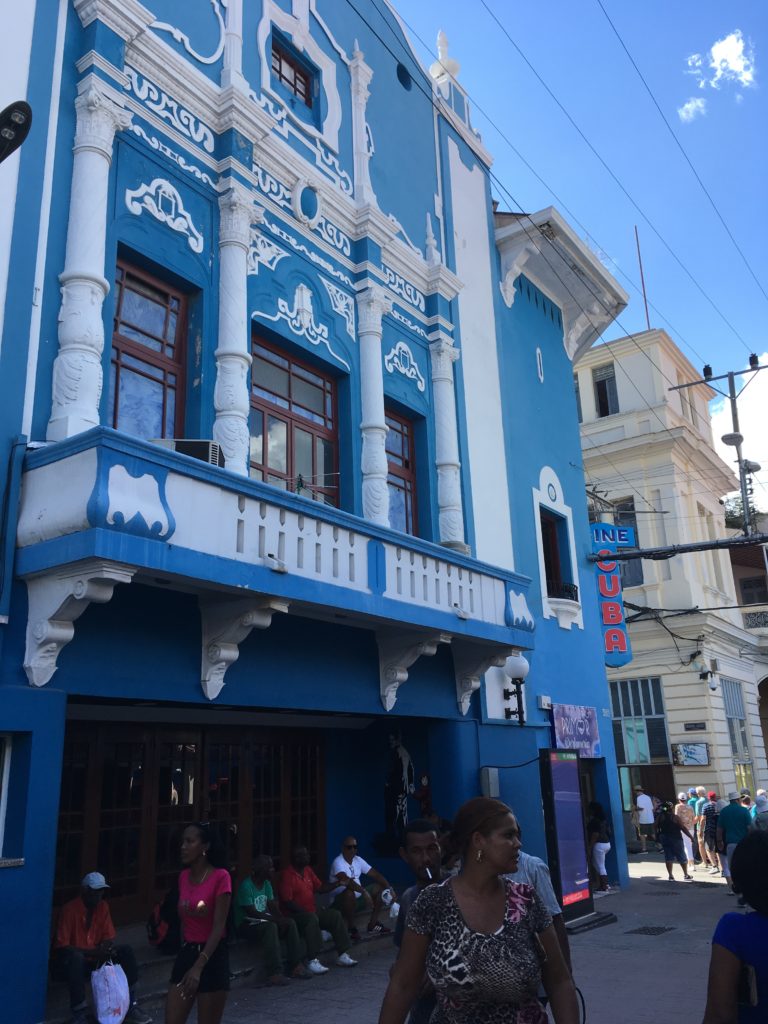She wore a blood-red shirt, too tight on her chest, but clean and pressed as if she was going somewhere special. The top button was missing, and the next buttonhole was being held by a pin. Her skirt was also tight fitting, had seen its better days and held by a worn-out belt. Her hair was upswept, as I imagine she kept it in her younger days when she was still eager to find the man of her dreams. She was still trying in her seventh decade of life. I could only detect only one tooth in the front of her mouth, the rest were worn out. She approached me with a look of confidence, as if we had something in common, and we did .

She patted my belly and looked deep into my eyes, she said: “You have had two children. You love them more than life itself. I can tell because I have four of my own, and I feel the same way.” She then patted my knee. She said: “you have broken this before.” In truth is was my ankle but it was close enough. Who was I to argue with Santeria? I was mesmerized by this woman, she looked about 75 years old but maybe she had a hard life that made her look older. She then looked at me deep in my eyes and asked the million-dollar question: “Tienes champú?” She asked me for shampoo. Welcome to Cuba, the land of beauty but no frills. Approaching strangers with no fear, Santeria knowledge galore, using a confident edge and asking for the things you can’t find. I was sad not to be able to supply her need for beautiful hair. She smiled and said: “No importa. Pero ruegue por nosotros. Dígales que vengan. Necesitamos turistas.”
Pray for us. Cuba needs tourists, tell them to come.
Speaking Spanish fluently has its advantages. You can negotiate better rates. You can understand what people are saying behind your back, but best of all, you can really talk to the people in a way no tour agent can translate. You can get to the bottom line…more or less. If the bottom line is truthful. But sometimes hearing the truth is hard to swallow.

Arriving in Cuba was a double-edged sword. As we approached the coast of Cienfuegos in luxury, in an almost silent, skimming ship, I sat in our balcony and absorbed the coastline. Colors burst as if they were too eager to wait for us. Red, yellow, blue. I did not know what to expect. I watched as we slithered into the beautiful bay, holding a champagne glass without guilt, hearing the children greet us with cascades of laughter followed by cries of “Mándenos arroz”. Send us rice. On the ship, people waved back mindlessly not knowing what these children were screaming, drowned by the sounds of roosters crowing and people waking up to see us arrive on their beautiful land.
As the child of a Russian immigrant who had escaped communism from his home country, I felt very confused. Do you go and visit a country that is still under the weaker but still present iron curtain? Do you support a regime that has completely uprooted your ancestors? How do you handle such feelings without guilt? I made the best decision I could at the time. I decided I wanted to see Cuba and forget the politics. Travel is always a good idea.
The first thing to do in Cuba is to exchange money. This is very easy, the little kiosks are set up right after you pass immigration, also a breeze with the cultural visas obtained for the trip. If you bring Euros or other foreign money, they will take a 3% commission and give you Cuban Convertible Pesos, the money tourist use. However, if you bring dollars, there is a 13% charge. Both ways if you don’t spend it all. Be careful to get the right currency (the ones with the monuments on them) because the local currency is worth five times less. One Convertible Peso is equal to one dollar.

We were finally in Cienfuegos where we ventured out on our own to visit the city. My husband was determined to get away from canned tours and get to know the country and the people. We had not walked 100 yards when a young man accosted us to sell us on his bicycle-taxi ride. He was eager to make a deal, so the 30 Convertible Peso asking price became 15 very quickly. It was probably worth 5. His makeshift vehicle was there waiting for us even though we had the feeling that we could have walked into town in 10 minutes. A policeman came and interceded. Took his license and told him to come back in the afternoon to get it back. That’s what made up our minds to hire him. We didn’t need him, but he would need that money to get his permit back later. He took us into town and waited for us on a side street. He said he did not have permission to stay on the main street. He patiently waited for an hour while we visited beautiful forgotten mansions, empty houses where there once flourished ostentatious lives, public squares where important people had made forgotten speeches. We entered the shop of a local artist. He was hard at work, painting views of Cuba with the iconic American cars. He had talent, and he wanted to show us his work. We told him we would be back, and he believed us. No stress, no pressure to sell. We did come back and bought one of his paintings, posed for a picture with the artist, enjoyed our bartering and normalcy.
Havana was waiting for us. We boarded the bus with numerous other tourists, hanging the must-have whisperers around their necks as if our lives depended on it. Everyonel had to check the right channel, you did not want to miss a word from the tour guide. She introduced herself as “Jenny” and insisted on telling us that no question was off-the-record. Anything could be asked. Anything. We took off in the pristine countryside as we discussed history, politics, the average worker wages of $16 a month, an allowance of food for everyone, free healthcare and education, free housing….and the happiness factor. No crime. Yet. No corruption, almost. Everyone was dealing under the table in order to make ends meet. But Cuba is safe.

Havana greeted us like a well-dressed, respectable Cuban woman of a certain age, make up hiding certain imperfections. Beautiful, passionate, a bit tired but still willing to show off. I was blown away by her beauty, taken in by her fervor, swept up in her energy. Music, sights, colors. Everything you can expect plus more.
During our walkabout, our tour guide tells us about the bar where Hemingway hung out long ago. According to the story, he was drinking some light rum one afternoon in his hacienda, as he did so often, when he just happened to take a sprig of “hierbabuena”, (a type of mint plant) from his garden and absentmindedly stuck it in his mouth. The mixture worked better after adding some sugar and the Mojito was born. He then asked his favorite bartender to make it for him and years later, tourists still line up to share his legacy. Our tour guide tells us these are not the best but, what the heck, when in Cuba…and my husband and I ditch the group. We leave them as they are admiring the handmade dolls in front of a church and we seek out La Bodeguita del Medio. No need to get an address, just follow the crowd there. A dozen or so mint-stuffed glasses line up on the bar, waiting for the eager buyers who will plunk down the five CUC for the mixture. The bartender makes an effort to expertly mash the green leaves with a wooden pestle and pours the rum with flair. We share one, it is early in the day! It is not the best, but not the worst. But the sheer experience of being there, of seeing the graffiti on the wall, the signed notes from Hemmingway, well, it makes for great atmosphere and we order another one.

We assemble in a colorful square, tourists running to meet their respective group, clutching boxes of “state-store” purchased cigars. We see a man selling cone shaped paper holders. Maní. Roasted peanuts. On his faded t-shirt is the face of my favorite soccer player, Zinedine Zidane. We buy two slim cones with perhaps 15 peanuts in them for 50 cents. He asks for one CUC, the Cuban equivalent of one dollar. Soon, after seeing us eat the hot crispy nuts, others in our group get the courage to buy street food and buy four for one CUC. He smiles and approaches me to give me the extra two cones to make it fair. We smile at each other. Zidane has brought us together.

One of the most iconic sights in Cuba are the old, refurbished and pristine cars left on the island by the Italian-American coterie that enjoyed the life of gambling in the fifties. It was a dream to build casinos in Havana, to make it larger than Las Vegas. But that dream never solidified. The life once imagined went up in smoke and they had to leave the country and their beautiful cars behind. We board a bright green 1951 Chevy and tour Havana with style. The houses, the monuments, the large avenues take on a different panache. Sixty cars line the streets, pink, yellow, green. Havana dreams of days gone by. Our driver tells us the motor is the original engine and he beams with pride.

Santiago de Cuba is our next stop. It once was the capital and we have two hours to see the hustle and bustle of the city center. People line the main pedestrian avenue and walk purposefully to their assigned jobs. Most look at us with curiosity and want to talk. One man approaches my husband who is admiring the gold chains in a store window. He warns him they are fake, and his skin will turn green after wearing them. We all share a laugh. A line forms in front of an empty store, people scurrying to secure their spot holding large bags. It’s the monthly distribution of allotted food. One kilo of rice, one kilo of black beans, five eggs, a litter of milk if you have a child under seven. Everyone politely waits their turn in line as we walk by.

Our tour guide takes us dutifully to another state-owned store. More cigars and rum. More overpriced t-shirts that I will never wear. I turn to my husband and we leave the store to admire the main square instead. A man comes up to us and asks if we want to buy cigars. “No, thank you” I say to him in Spanish, “we have bought all we need, and we don’t even smoke”. But his eyes open wide when he hears me speak his language and continues his pitch. “But you haven’t shopped at the cooperativa”. My husband’s face lights up, “Cooperativa?” and I know I have a lost cause in fighting this. A local adventure that lets you meet the real Cubans in a co-op store! Our new friend tells us it’s right around the corner (and I fall for this!). We follow him one block, two blocks and I can tell there is no “cooperativa”. These are all run down apartments, no business sign in sight. We follow him up a rusted, dilapidated staircase to the second floor. The wall has broken tiles, halfway hanging for dear life. I feel the faded blue squares will come unglued any second. I keep reminding myself of the low crime rate in Cuba or I would never get in this mess. My husband is smiling from ear to ear in delight.
We arrive to his store, or apartment. The living room is barely larger than my own bathroom, furnished with a rusty Frigidaire from the 50’s. A hot plate next to it has remnants of the rice and beans someone had for lunch. The couch is higher on one side, probably because of the broken leg underneath. Its upholstery has certainly seen better days. By the corner of my eye I spot a woman in the bedroom, wearing a gray duster, looking more suspicious of us than we are of them. The man asks her to bring the cigars. She raises a tablecloth covering an old cabinet, slowly opens a drawer where a large box opens to pandora’s treasure. Boxes and boxes of cigars of every kind. The bargaining starts but I want to leave. Our bus back to the ship is waiting and I don’t want to miss it. We finally leave with some cigars, our friend did not make a big sale but probably has made enough for a month’s salary. We run to join our group with a secret joy of adventure. The others are also happy with bags full of t-shirts, rum and cigars.

The trip to Cuba seems so short. There is so much more to explore, to see, to discuss. Hemingway has made such an impression on this country, but the political heroes are prominent. Che Guevara, Fidel Castro, Raul. You can’t miss their larger-than-life figures painted on the sides of buildings. Life seems to be more normal than what the people of Cuba knew for over 60 years. But it will take a long time to catch up. Internet is not available, just intranet. Which means their news are filtered and monitored. Poverty is real, but the Cubans are hardy people who know how to work the system. They are also happy and very proud of their country. As well they should be. This is one of those trips I can’t wait to do again. Perhaps on our own, driving across the country, meeting more people, hearing more music, and sharing our lives.
Next time I will bring lots and lots of champú.
“Travel makes one modest. You see what a tiny place you occupy in the world.”
-Gustave Flaubert
